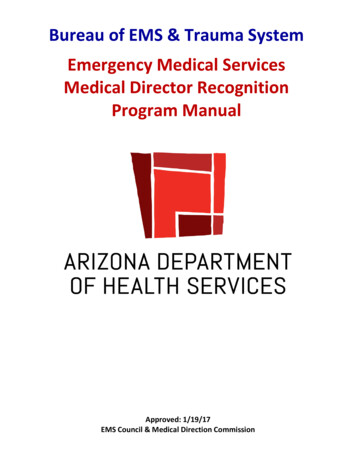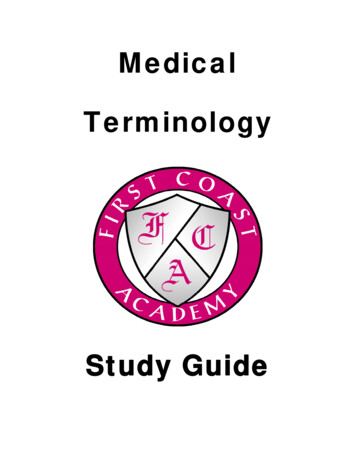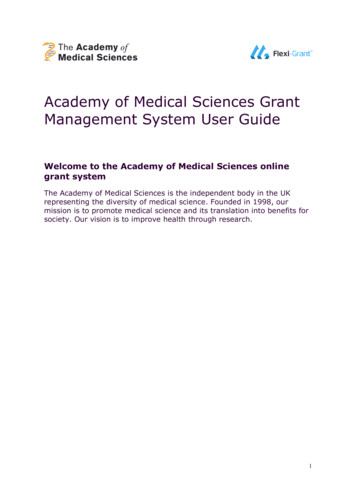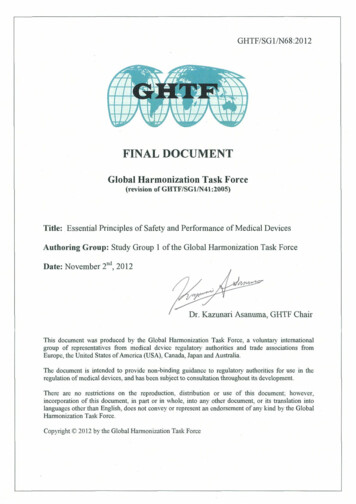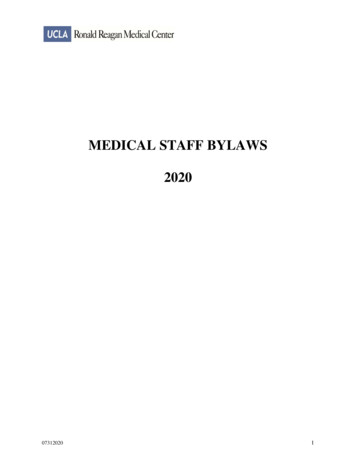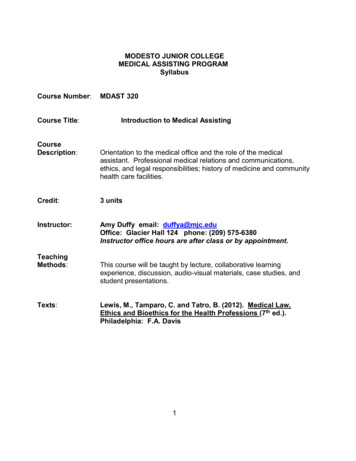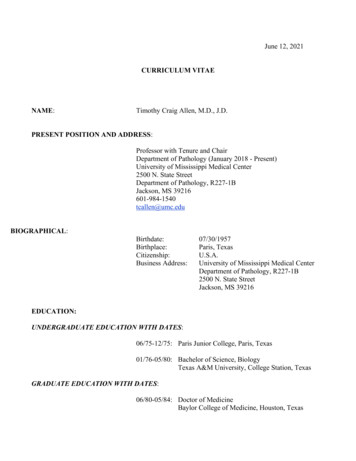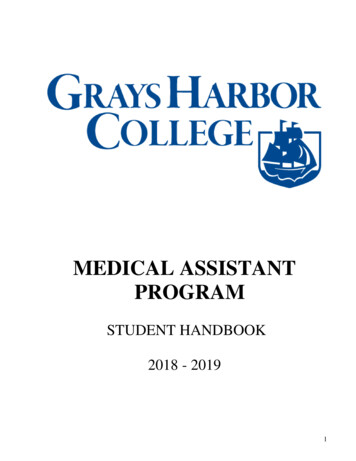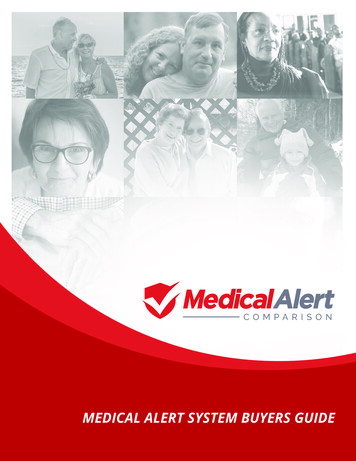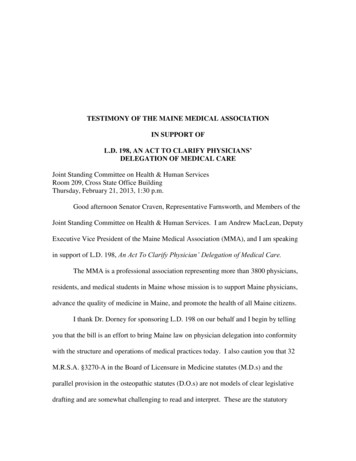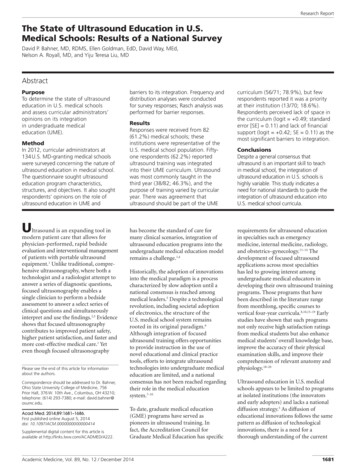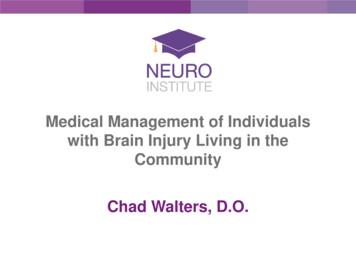
Transcription
Medical Management of Individualswith Brain Injury Living in theCommunityChad Walters, D.O.
Outline Common Medical Problems– Post-traumatic Seizures/Epilepsy– Spasticity– Depression/Anxiety– Agitation/Aggression– Sleep disorders– Attention deficits Medications and side effects for each
Medication Management PhilosophyMedicationManagement Philosophy Start low and go slowChange one medication at a time– Adding/stopping medications– Changing dosesLook for medications that can be eliminated before adding othersGive adequate time for therapeutic effectEducate patients and families on reasonable outcomes, targeted effects, side effectsTreat the “Why” and not the “What”
Post-traumatic Seizures Post-traumatic Seizures– Immediate: first 24 hours– Early: 1 – 7 days– Late: after 7 days Post-traumatic Epilepsy– Two or more late onset seizures separated by at least 24 hours that is notattributable to other causes (Infections, Electrolytes, Medications)
Post-traumatic Seizures Generalized– Bilateral hemisphere involvement– Also known as “Grand Mal”– Nearly all involve loss of consciousness (LOC) Partial– Unilateral involvement– Complex or Simple Complex: ( ) LOC Simple: (-) LOC– Most common form found in TBI
Post-traumatic Seizures Generalizations:– 80% of seizures will develop in first 2 years– Neuro-imaging is NOT helpful in predicting PTS– EEG is NOT helpful in predicting PTS False positives and negatives are common
Post-traumatic Seizures Treatment– Only treat late-onset seizures– Tegretol, Depakote, Lamictal, Topamax, Vimpat, Trileptal, Keppra– Duration is physician dependent 1st seizure: 18 months– Goal is to limit potentially cognitive sedating meds as much as possible 2nd Seizure: 2 years 3rd seizure: lifetimeSeizures lasting longer than 5 minutes have a high risk of developing statusepilepticus
Post-traumatic Seizures Medications– Tegretol (Carbemazepine)– Depakote (Valproic Acid)– Lamictal (Lamotrigine)– Topamax (Topiramate)– Keppra (Levetiracetam)– Vimpat (Lacosamide)– Trileptal (Oxcarbazepine)
Post-traumatic Seizures Mechanism of Action– Stabilizes cell membranes to decrease frequency of spontaneous firing Common Side Effects– Lethargy– Confusion– Dizziness/Gait unsteadiness– Weight gain– Hepatotoxicity– Pancytopenia
Post-traumatic Seizures Monitoring levels– Can get levels on any anti-seizure medication to assure therapeutic range– CBC, CMP and drug levels every 3 months Toxicity effects– Marked lethargy/somnolence– Hallucinations/Paranoid delusions– Fever– Depression
Spasticity Definition: Velocity dependent increase in muscle tone with resistance to stretch Occurs due to deficiency or absent of descending inhibitory pathways– Gamma Amino Butyric Acid (GABA) is the primary inhibitory neurotransmitter thatturns off the spinal reflex
Spasticity
Spasticity Treatments– PT/OT for stretching, splinting/casting and modalities (heat, ice, ultrasound, EStim)– Oral Medications Baclofen, Dantrium, Zanaflex– Injections Botulinum toxin, Phenol– Invasive treatments Intrathecal Baclofen pump Tendon lengthening procedures
Spasticity Medications– Baclofen 5-20mg TID Enhances effect of GABA in the CNS in effort to “turn off” the spinal reflexpathway Side effects: weakness, lethargy, confusion, dizziness, respiratory distress Withdrawal: increase muscle tone, itching (without presence of a rash),hallucinations (usually visual), seizures, fever, death Oral or Intra-thecal preparations
Spasticity Medications (cont.)– Dantrium (Dantrolene Sodium) 50-100mg BID or TID Inhibits muscle activity at the muscle itself (only agent that works at themuscle level). Inhibits Calcium release from the sarcoplasmic reticulum. Side effects: Hepatotoxicity, weakness, lethargy Monitoring: CBC, CMP every 3 months
Spasticity Medications (cont.)– Zanaflex (Tizanidine) 2-8mg TID Inhibits descending excitatory pathways both at the brain and spinal cordlevels Usually used as an adjunct to other medications Side effects: hypotension, sedation, fatigue, dizziness, hepatotoxicity
Spasticity Injectible treatments– Botulinum toxin (Botox, Myobloc, Dysport) Inhibit the release of Acetylcholine into the synapse to prevent musclecontraction Best if localization measures are used– EMG, Electrical stimulation, Ultrasound Side effects: Muscle irritation, localized pain, fever, nausea, dysphagia (ifused close to the neck) FDA approved for upper extremity spasticity and cervical dystonia only
Depression Definition: psychological disorder that presents as a depressed mood, lost of interestor pleasure, feelings of guilt or low self-worth– Not just feeling “sad” Patients often claim to feel “lost in the world” Pathophysiology– deficiency in serotonin, norepinephrine and/or dopamine in the Central NervousSystem
Depression Medications should be used in conjunction with psychotherapy and counseling Medication classes– SSRI– SNRI– TCA– “Novel”
Depression SSRIs– Selectively inhibits the reuptake of Serotonin in the synapse making it moreavailable to the post-synaptic membrane
DepressionSSRI Mechanism of Action
Depression SSRIs (cont.)– Zoloft (Sertraline) 50-150mg daily– Paxil (Paroxetine) 20-50mg daily– Celexa (Citalopram) 10-40mg daily– Lexapro (Escitalopram) 10-20mg daily– Prozac (Fluoxetine) 20-80mg daily
Depression SSRIs (cont.)– Side effects: Nausea, Vomiting, Diarrhea, Dry mouth, sedation (esp with Paxil),delayed ejaculation, decreased libido, serotonin syndrome (especially when usedwith other SSRI’s)– Must give 3-4 weeks trial before changing dose or switching medications
Depression SNRIs– Inhibits the reuptake of Serotonin and Norepinephrine in the nerve synapse
DepressionSNRI Mechanism of Action
Depression SNRIs (cont.)– Cymbalta (Duloxetine) 30-60mg daily– Effexor (Venlafaxine) 37.5-75mg BID or TID– Pristiq (Desvenlafaxine) 50mg daily– Side effects: Insomnia, nausea, vomiting, diarrhea, seizures, HTN, heartarrythmias, anxiety, agitation/aggression
Depression TCAs (Tricyclic/Tetracyclic Antidepressants)– Inhibits re-uptake of Norepinephrine, Serotonin and Histamine at the synapse– Anticholinergic effects which limit use in TBI population and is cause for mostcommon side effects
DepressionTCA Mechanism of Action
Depression TCAs (Tricyclic/Tetracyclic Antidepressants)– Elavil (Amitriptyline) 50-150mg qhs– Pamelor (Nortriptyline) 50-150mg qhs– Anafranil (Clomipramine) 50-250mg qhs
Depression TCAs (Tricyclic/Tetracyclic Antidepressants)– Side effects: Memory loss, attention and concentration deficits, sedation,confusion, delerium, hypotension, urine retention, constipation– Used mostly in TBI population for sleep disorders, not depression
Depression “Novel” Group– Wellbutrin (Buproprion) 50-150mg BID Inhibits reuptake of serotonin, norepinephrine and dopamine at nervesynapse Useful for depression and attention/concentration deficits Side effects: anxiety, insomnia, seizures, hallucinations– Remeron (Mirtazapine) 15-30mg qhs Used mostly for sleep disorders and poor appetite– Trazodone Used predominately for sleep disorders
Anxiety Definition: psychological disorder presenting as feelings of fear, uneasiness and/orrestlessness– Situational or Generalized Commonly accompanies depression as a clinical syndrome
Anxiety Situational– Panic disorder usually triggered by an external stimulus– Crowded areas such as malls, grocery stores, events, etc – Includes social phobias, OCD and PTSD Generalized– Constant feeling of tension, uneasiness, fear
Anxiety Generalized– SSRIs Paxil 10-40mg daily Celexa 10-40mg daily Lexapro 10-20mg daily Zoloft 50-150mg daily– Beta-blockers Propranolol 20-60mg BID or TID - scheduled
Anxiety Situational– Anxiolytics Short Acting (half-life 8-10 hours)– Xanax (Alprazolam) 0.25-1mg TID prn– Serax (Oxazepam) 10-30mg TID Medium acting (half-life 10-14 hours)– Ativan (Lorazepam) 2-6mg/day divided BID or TID prn– Estazolam 1-2mg qhs prn
Anxiety Situational– Anxiolytics (cont.) Long Acting (half-life 20-40 hours)– Klonopin (Clonazepam) 0.5-5mg TID– Valium (Diazepam) 2-10mg BID to TID– Dalmane (Flurazepam) 10-30mg qhs Non-Benzodiazepine– Vistaril (Hydroxyzine) 25-50mg TID– Inderal (Propranolol) 10-30mg TID– Used mostly on an as needed basis
Anxiety Side effects– Benzodiazepines (all classes) Lethargy, Drowsiness, Dizziness, Confusion, Delerium, Ataxia, Potential forabuse/addiction, Respiratory depression– Vistaril Dry mouth, dizziness, lethargy, drowsiness– Inderal Drowsiness, hypotension, bradycardia, depression
Agitation A psychological state manifested by verbal and/or physical aggression or rageUsually caused by an external trigger, but not alwaysMust identify what is causing the agitation in order to treat it effectively– Commonly not mood instability but rather an underlying anxietydisorder, sleep disorder or depressionPhysiologically is a state of sympathetic overdrive and/or excessive dopamineTreatments are aimed at controlling these physiologic changes
Agitation Treatments– Mood Stabilizers Depakote 250-1500mg BID Tegretol 100-400mg BID– Atypical Antipsychotics Risperdal 1-3mg BID Seroquel 50-200mg BID Zyprexa 5-20mg at night Geodon 20-80mg BID
Agitation Treatments– Typical Antipsychotics Haldol Thorazine Compazine– These agents should NEVER be used for maintenance therapy in brain injurypatients– Evidence of delayed and incomplete cognitive recovery– Tardive Dyskinesia
Agitation Treatments– Maintenance therapy (cont.) Beta-blockers– Propranolol 20-60mg BID or TID Anxiolytics– Hydroxyzine 50-100mg TID– Clonazepam 1-3mg BID Antidepressants– SSRIs Neurostimulants– Ritalin, Adderall, Concerta, Strattera
Sleep disorders Difficulty with initiation, maintenance or bothMust take a thorough history in order to treat sleep problems effectively– Night time routines– Caffeine intake– Napping during the day– Headaches– Awakening due to other medical problems Pain, Urination, muscle spasms
Sleep disorders Treatment– First line is environmental changes “Settling down” period at night Relative dark environment with little/no noises No caffeine after 7pm– If headaches are associated, may need to get a sleep study Spouse/significant other reports patient snores excessively– Treat any underlying medical problem that is contributing
Sleep disorders Treatment– Initiation only problem Brain can’t “shut down” at night Once patient can get to sleep they can stay asleep for 6-8 hours– Melatonin» 3-6mg at night about an hour prior to wanting to go to sleep– Trazodone» 50-150mg at night
Sleep disorders Treatment– Maintenance or combined problem Patients have difficulty getting to sleep and staying asleep .OR .can getto sleep fine, but have trouble staying asleep Awaken 5-7 times per night Again .must treat any underlying medical cause
Sleep disorders Treatment– Maintenance or combined problem Medications– Restoril (Temazepam) 15-30mg at night– Ambien 5-10mg at night
Sleep disorders Side effects– Melatonin: nightmares, sleepwalking, headaches– Trazodone: headaches, dizziness, nausea, vomiting, dry mouth– Restoril: drowsiness, fatigue, “hangover” effect, dizziness– Ambien: sleepwalking, night terrors, hallucinations, dizziness, lethargy,“hangover” effect
Attention deficits Inability to maintain focus and concentration on visual or auditory tasksCommon with Frontal and/or Temporal lobe injuriesPhysiologically is a deficiency in the dopaminergic and/or noradrenergic pathwaysCan be associated with or without a hyperactivity componentAgain, a thorough history needs to be taken before any agent should be started– Heart disease (personal or family), seizures, sleep disorders, psychosis
Attention deficits Clinical presentations– Poor memory– Agitation– Frustration– Irritability– Tangential speech– Restlessness (hyperactive)
Attention deficits Treatment– Neurostimulants Ritalin – blocks the re-uptake and increases the release of Norepinephrine(and some Dopamine) at the synaptic terminal– 5-20mg every morning and noon– Side effects: Agitation, hallucinations, mania, hypertension,tachycardia, anorexia. Anxiety, insomnia Adderall – same as Ritalin but with less Dopamine effects– 10-20mg every morning and noon– Side effects: Same as Ritalin
Attention deficits Treatment– Dopaminergics Amantadine: Increases the release of dopamine from the pre-synapticmembrane– 100-200mg every morning and noon (should not be taken after 3pm)– Side effects: Hallucinations, Seizures, Irritability, Anxiety, Insomnia Bromocryptine: Blocks the re-uptake of dopamine from the synapse– 2.5-10mg every morning and noon (should not be taken after 3 pm)– Side effects: Same as Amantadine
Attention deficits Treatment (cont.)– Concerta and Strattera have not been well studied in TBI population and shouldbe avoided unless necessary– Antidepressants Wellbutrin 50-150mg BID
Summary Start low and go slowChange one thing at a time if possibleKnowing side effect profiles and goals of treatment are vitalEducation is importantTreat problems, not symptoms
Thank You!!
with Brain Injury Living in the . Seizures lasting longer than 5 minutes have a high risk of developing status epilepticus . Post-traumatic Seizures Medications - Tegretol (Carbemazepine) . Inhibits descending excitatory pathways both at the brain and spinal cord levels Usually used as an adjunct to other medications .
